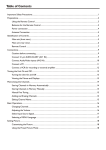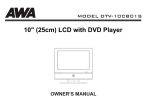Download Harwa LCD-TV LC-20H3S (Silver) 20" Silver
Transcript
LCD TV Operating Manual LC-20H3S Before connecting, operating or adjusting this product, please read the manual completely. Please keep this manual for future reference. Table of Contents Important Safety Precautions..........................................................................................................................1 Preparations....................................................................................................................................................3 Using the Remote Control .....................................................................................................................3 Batteries for the Remote Control ..........................................................................................................3 Power connection ..................................................................................................................................4 Antenna Connection ..............................................................................................................................4 Identification of Controls ................................................................................................................................5 Main unit (front view).............................................................................................................................5 Main unit (rear view) ..............................................................................................................................6 Remote Control .....................................................................................................................................7 Connections....................................................................................................................................................9 Cautions before connecting ...................................................................................................................9 Connect 21-pin EURO-SCART (AV1 IN)...............................................................................................9 Connect Audio/Video inputs (AV2 IN) .................................................................................................10 Connect a PC .......................................................................................................................................11 Connect a VCR for recording...............................................................................................................12 Turning the Unit On and Off.........................................................................................................................13 Turning the Unit On and Off ................................................................................................................13 Viewing the Menus and Displays ..........................................................................................................13 Memorizing the Channels .............................................................................................................................14 Storing Channels in Memory Automatically .........................................................................................14 Storing Channels in Memory Manually .................................................................................................14 Manual Fine Tuning ...............................................................................................................................15 Adding and Erasing Channels ...............................................................................................................15 Editing Channel Name..........................................................................................................................15 Basic Operations...........................................................................................................................................16 Changing Channels ...............................................................................................................................16 Adjusting the Volume ...........................................................................................................................16 Select Input Source Signal.....................................................................................................................17 Selecting a MENU Language ................................................................................................................17 Setting Picture...............................................................................................................................................18 Customizing the Picture .......................................................................................................................18 Using the Preset Picture Mode ............................................................................................................18 WIDE Mode Settings ............................................................................................................................18 Table of Contents (continued) Setting System ..............................................................................................................................................19 Setting Blue Screen Background ..........................................................................................................19 Setting Color and Sound System..........................................................................................................19 Setting Scart Output ............................................................................................................................19 Timer Function.............................................................................................................................................20 Setting Sleep Time ...............................................................................................................................20 Setting Current Time ...........................................................................................................................20 Setting On Timer .................................................................................................................................20 Setting Off Timer .................................................................................................................................20 OSD Settings ................................................................................................................................................21 Setting OSD Position............................................................................................................................21 Setting OSD Background .....................................................................................................................21 Setting OSD Timeout ..........................................................................................................................21 Setting Sound................................................................................................................................................22 Adjusting Sound Settings ......................................................................................................................22 Using the Preset Sound Mode .............................................................................................................22 Loading Preset Sound Settings for Headphone....................................................................................22 NICAM Broadcast Selection ................................................................................................................23 IGR (German stereo system) Broadcasts.............................................................................................24 Adjustment in VGA Mode ............................................................................................................................25 Customizing the Picture.......................................................................................................................25 Customizing the Color Temp...............................................................................................................25 Adjusting the Picture Automatically .....................................................................................................25 Changing the Position of Image............................................................................................................26 Adjusting the Phase and Frequency .....................................................................................................26 Setting Sleep Time ...............................................................................................................................26 Teletext.........................................................................................................................................................27 What is Teletext ...................................................................................................................................27 Turning on and off Teletext ..................................................................................................................27 Button functions...................................................................................................................................27 Troubleshooting............................................................................................................................................28 Specifications ................................................................................................................................................29 Dimensional Drawings .................................................................................................................................30 Important Safety Precautions Electrical energy can perform many useful functions, but it can also cause personal injuries and property damage if improperly handled. This product has been engineered and manufactured with the highest priority on safety. But IMPROPER USE CAN RESULT IN POTENTIAL ELECTRICAL SHOCK OR FIRE HAZARD. In order to prevent potential danger, please observe the following instructions when installing, operating and cleaning the product. To ensure your safety and prolong the service life of your LCD TV product, please read the following precautions carefully before using the product. 1. Read these instructions---All operating instructions must be read and understood before the product is operated. 2. Keep these instructions---These safety and operating instructions must be kept in a safe place for future reference. 3. Heed all warnings---All warnings on the product and in the instructions must be observed closely. 4. Follow all instructions---All operating instructions must be followed. 5.Attachments---Only use attachments/accessories specified by the manufacturer. Do not use attachments not recommended by the manufacturer. Use of improper attachments can result in accidents. 6. Power source---This product is intended to be supplied by a listed power supply indicated on the marking label. If you are not sure of the type of power supply to your home, consult your product dealer or local power company. For added protection for this product during a lightning storm, or when it is left unattended and unused for long periods of time, unplug it from the wall outlet and disconnect the cable system. 7.Power cord protection---Protect the power cord from being walked on or pinched particularly at plugs, convenience receptacles, and the point where they exit from the apparatus. 8.Overloading---Do not overload wall outlets, extension cords, or convenience receptacles on other equipment as this can result in a risk of fire or electric shock. 9.Entering of objects and liquids---Never insert an object into the product through vents or openings. High voltage flows in the product, and inserting an object can cause electric shock and/or short internal parts. For the same reason, do not spill water or liquid on the product. 10. Servicing---Refer all servicing to qualified service personnel. Servicing is required when the apparatus has been damaged in any way, such as power-supply cord or plug is damaged, liquid has been spilled or objects have fallen into the apparatus, the apparatus has been exposed to rain or moisture, does not operate normally, or has been dropped. 11.Damage requiring service---If any of the following conditions occurs, unplug the power cord from the AC outlet, and request a qualified service person to perform repairs. a. When the power cord or plug is damaged. b. When a liquid is spilled on the product or when objects have fallen into the product. c. When the product has been exposed to rain or water. d. When the product does not operate properly as described in the operating instructions. Do not touch the controls other than those described in the operating instructions. Improper adjustment of controls not described in the instructions can cause damage, which often requires extensive adjustment work by a qualified technician. e. If the product has been dropped or the cabinet has been damaged in any way. f. When the product displays an abnormal condition or exhibits a distinct change in performance. Any noticeable abnormality in the product indicates that the product needs servicing. 12. Replacement parts---In case the product needs replacement parts, make sure that the service person uses replacement parts specified by the manufacturer, or those with the same characteristics and performance as the original parts. Use of unauthorized parts can result in fire, electric shock and/or other danger. 13. Safety checks---Upon completion of service or repair work, request the service technician to perform safety checks to ensure that the product is in proper operating condition. 14. Wall or ceiling mounting---When mounting the product on a wall or ceiling, be sure to install the product according to the method recommended by the manufacturer. This is a safety feature. 1 Important Safety Precautions (continued) 15. Stand---Use only with the cart, stand, tripod, bracket, or table specified by the manufacturer, or sold with the apparatus. Do not place the product on an unstable trolley, stand, tripod or table. Placing the product on an unstable base can cause the product to fall, resulting in serious personal injuries as well as damage to the product. When mounting the product on a wall, be sure to follow the manufacturer’s instructions. Use only the mounting hardware recommended by the manufacturer. 16.Careful move---When a cart is used, use caution when moving the cart/apparatus combination to avoid injury from tip-over. Sudden stops, excessive force and uneven floor surfaces can cause the product to fall from the trolley. 17. Lightning---Unplug this apparatus during lightning storms or when unused for long periods of time. For added protection for this television equipment during a lightning storm, or when it is left unattended and unused for long periods of time, unplug it from the wall outlet and disconnect the antenna. This will prevent damage to the equipment due to lightning and power-line surges. 18. Do not use this apparatus near water---for example, near a bathtub, washbowl, kitchen sink, or laundry tub, in a wet basement, or near a swimming pool, and the like. Do not use immediately after moving from a low temperature to high temperature environment, as this causes condensation, which may result in fire, electric shock, or other hazards. 19. Clean only with dry cloth---Unplug this product from the wall outlet before cleaning. Do not use liquid cleaners or aerosol cleaners. Use a damp cloth for cleaning. 20. Ventilation---Do not block any ventilation openings. Install in accordance with the manufacturer instructions. The vents and other openings in the cabinet are designed for ventilation. Do not cover or block these vents and openings since insufficient ventilation can cause overheating and/or shorten the life of the product. Do not place the product on a bed, sofa, rug or other similar surface, since they can block ventilation openings. This product is not designed for built-in installation; do not place the product in an enclosed place such as a bookcase or rack, unless proper ventilation is provided or the manufacturer’s instructions are followed. 21.Heat sources---Do not install near any heat sources such as radiators, heat registers, stoves, or other apparatus (including amplifiers) that produce heat. 22.Panel protection---The LCD panel used in this product is made of glass. Therefore, it can break when the product is dropped or impacted upon by other objects. Be careful not to be injured by broken glass pieces in case the LCD panel breaks. 23.Pixel defect---The LCD panel is a very high technology product, giving you finely detailed pictures. Occasionally, a few non-active pixels may appear on the screen as a fixed point of blue, green or red. Please note that this does not affect the performance of your product. 2 Preparations Using the Remote Control <Use the remote control by pointing it towards the remote sensor window of the set. Objects between the remote control and sensor window may prevent proper operation. Note: the illustration is for your reference only, the remote sensor may locate differently with different model. 30 30 5m Cautions regarding use of remote control <Do not expose the remote control to shock. In addition, do not expose the remote control to liquids, and do not place in an area with high humidity. <Do not install or place the remote control under direct sunlight. The heat may cause deformation of the unit. <The remote control may not work properly if the remote sensor window of the main unit is under direct sunlight or strong lighting. In such a case, change the angle of the lighting or LCD TV set, or operate the remote control closer to the remote sensor window. Batteries for the Remote Control If the remote control fails to operate the LCD TV functions, replace the batteries in the remote control. 1 Open the battery cover. <(Slide the cover while pressing down.) 2 Insert two size-AAA batteries. 3 Replace the cover and slide in reverse until the lock snaps. <(Place the batteries with their terminals corresponding to the (+) and (–) indications in the battery compartment.) Precaution on battery use Improper use of batteries can result in a leakage of chemicals and/or explosion. Be sure to follow the instructions below. <Place batteries with their terminals corresponding to the (+) and (–) indications. <Different types of batteries have different characteristics. Do not mix batteries of different types. <Do not mix old and new batteries. Mixing old and new batteries can shorten the life of new batteries and/or cause old batteries to leak chemicals. <Remove batteries as soon as they are non-operable. Chemicals that leak from batteries can cause a rash. If chemical leakage is found, wipe with a cloth. <The batteries supplied with the product may have a shorter life expectancy due to storage conditions. <If the remote control is not used for an extended period of time, remove the batteries from the remote control. 3 Preparations (continued) Power connection Household power outlet Plug into AC outlet. AC cord AC adapter Connect to the DC input socket of the product. Be sure to insert plug into the end fully and confirm it is reliable 1. Connecting the female plug to the AC socket on AC adapter. 2. Connecting the AC adapter to the DC power input of the set. 3. Connecting the male plug to the wall outlet as illustrated. Note: <Always turn the Power Switch of the LCD TV set to OFF when connecting the AC adapter. <This product should be operated only from the type of power source indicated on the marking label. <Always unplug the AC adapter from the product and power outlet when not using for a long period of time. Antenna Connection INSTALL the unit in a room where direct light will not fall upon the screen. Total darkness or a reflection on the picture screen may cause eyestrain. Soft and indirect lighting is recommended for comfortable viewing. Optimum reception of color requires a good signal and will generally mean that an outdoor aerial must be used. The exact type and position of the aerial will depend upon your particular area. 75-ohm coaxial cable (round cable) To antenna input terminal ( ) 300-ohm twin-lead flat feeder Note: It is recommended that the 75-ohm coaxial cable be used to eliminate interference and noise which may occur due to radio wave conditions. The aerial cable should not be bundled with the power cord and the like. 4 Identification of Controls Main unit (front view) Control Panel SOURCE MENU Menu Select Input Signal Speaker CH CH VOL VOL Channel Down/Up POWER Power On/ Standby Volume Down/Up Speaker Remote Sensor Power Indicator A yellow indicator lights when the power is on and a red indicator lights when in the standby mode. 1. SOURCE To access the SOURCE select menu 2. MENU Press this button to access the MENU main page. 3. CH +/Change the TV channel. In OSD Menu, press these buttons to choose the OSD items. 4. VOL +/Increase or decrease the sound volume level. In OSD Menu, press these buttons to adjust the value or setting of each item 5. POWER Press this button to turn the unit ON from STANDBY mode. Press it again to turn the set back to STANDBY. Note: SOURCE, MENU, CH+/-, VOL+/- and POWER on the main unit have the same functions as the corresponding buttons on the remote control. This operation manual provides a description based on operating functions with the remote control. 5 Identification of Controls (continued) Main unit (rear view) 1 2 DC 12V VGA 3 PC - AUDIO S-VIDEO 4 VIDEO L AUDIO R AV2 IN 5 PHONE 6 VIDEO L AUDIO R 7 8 AV1 (SCART) AV OUT RF 1. DC POWER input Connect to the DC output of the Power Adapter. 2. VGA input /Audio in Connect to the VGA/audio output 3.5mm jacks on your PC. 3. S-Video input Receive a S-Video signal from external source such as VCR or DVD player. 4. AV 2 inputs (Video, Audio L, R) Receive video/audio signals from external sources such as VCR or DVD player. 5. Headphone 3.5mm jack 6. AV outputs (Video, Audio L, R) Connect to the VCR input jacks to record programs. 7. 21-pin Euro-SCART (RGB) interface/AV1input and Scart output 8. Antenna input 6 Identification of Controls (continued) Remote Control 1 10 2 3 11 4 5 12 13 6 7 14 15 8 9 Flip the cover, open in the direction of the arrow. 7 1. POWER Turn the unit on or standby 2. CH+/-,VOL+/CH+/- ---Use to switch channels; To display previous/next page (Teletext) VOL+/----Use to adjust volume; In MENU operation, use CH+/- to select item and VOL+/- to adjust selected item 3. MENU To access the MENU main page 4. STEREO To select stereo, mono or bilingual (select Left, Right or Stereo in AV or D-Sub mode) Red button (teletext) 5. SLEEP To access sleep time setting menu bar Green button (teletext) 6. Teletext To enter/exit teletext mode 7. P.P To select preset picture mode 8. 0~9 digit buttons, -/-- button 0~9: direct channel select; -/-- button: one digit/two digit/three digit channel number selector 9. SOURCE To access source select menu 10. MUTE Sound mute 11. To confirm your operation or setting or to exit menu To display channel status or program table 12. To increase brightness Blue button (teletext) 13. To decrease brightness Yellow button (teletext) 14. RETURN To quickly jump between current channel and last selected channel. 15. S.P To select preset sound mode Identification of Controls (continued) Remote Control 16 17 22 23 19 24 25 26 20 27 21 28 18 16. SCALER MODE To select screen aspect ratio 17. HEADPHONE To load preset sound settings for headphone 18. REVEAL To display hidden information such as solutions to riddles and puzzles. (Teletext) 19. REAL CLOCK To access real time quickly without entering teletext 20. INDEX To display index page (Teletext) 21. MIX To superimpose text on a TV picture (Teletext) 22. POS To quickly select OSD position 23. AUTO To adjust picture automatically 24. TIMER To access timer menu bar 25. SIZE To expand top half or bottom half page of current screen (Teletext) 26. HOLD To hold the current teletext page temporarily (Teletext) 27. To increase contrast (Teletext) 28. To decrease contrast (Teletext) 8 Connections Cautions before connecting Carefully check the terminals for position and type before making any connections. The illustration of the external equipment may be different depending on your model. Loose connectors can result in image or color problems. Make sure that all connectors are securely inserted into their terminals. Refer to the operating manual of the external device as well. When connecting an external device, turn the power off to avoid any issues. Connect 21-pin EURO-SCART (AV1 IN) Interface on the rear of the Unit DC 12V VGA PC - AUDIO S-VIDEO VIDEO L AUDIO R PHONE VIDEO AV2 IN RF AV1 (SCART) L AUDIO R AV OUT 20 18 16 14 12 10 8 Decoder 21 19 17 15 13 11 9 6 7 4 5 2 3 1 21-pin Euro-SCART connector 21-pin Euro-SCART (RGB) 1. Audio right output 2. Audio right input 3. Audio left output 8. AV control 9. Earth for green 10. Not used 15. RED input 16. RGB control 17. Earth for video 4. Common earth for audio 5. Earth for blue 6. Audio left input 11. GREEN input 12. Not used 13. Earth for red 18. Earth for RGB control 19. Video output 20. Video input (PAL/SECAM/NTSC) 7. BLUE input 14. Not used 21. Plug shield How to connect: Connect the 21-pin Euro-SCART between the unit and decoder. To watch decoder 1. Turn on your LCD TV , press Source button on the remote control. 2. Press CH+/- to select AV1 and press VOL+ to confirm or wait for about 5 seconds. 3. Turn on the decoder. 4. Set the Scart Output item (in System menu) to TV and select a proper channel through the Scart Output Channel item. For detailed operation, please refer to [Setting Scart Output] in page19. 9 SOURCE TV AV1 AV2 SVIDEO D-Sub Video1 Connections (continued) Connect Audio/Video inputs (AV2 IN) Interface on the rear of the Unit DC 12V VGA PC - AUDIO S-VIDEO PHONE L AUDIO R VIDEO AV2 IN Y S-Video cable or W VIDEO AV1 (SCART) L AUDIO R R Y Video Audio cable cable W R Y W RF AV OUT Yellow (VIDEO) White (AUDIO L/MONO) Red (AUDIO R ) R Examples of external devices that can be connected DVD player VCR Video Camera Home video game system The unit provides Audio/Video inputs for you to connect external devices such as VCR, Video Camera, DVD Player or Home video game system. How to connect: Connect the Audio/Video cables between the Audio (L/R)/Video jacks on the unit and external devices. To view signal from AV2 inputs 1. Turn on your LCD TV , press Source button on the remote control. 2. Press CH+/- to select AV2 or SVIDEO and press VOL+ to confirm or wait for about 5 seconds. 3. Turn on the external device and play it. Note: For better video, you can use the S-video terminal if your source supports it. If you are going to use S-video terminal, please select SVIDEO instead of AV2 in SOURCE menu. SOURCE TV AV1 AV2 SVIDEO D-Sub Video2 The Video input terminal on the AV2 IN and the S-Video input terminal share the same Audio input terminals. 10 Connections (continued) Connect a PC Interface on the rear of the Unit DC 12V VGA PC - AUDIO S-VIDEO VIDEO L AUDIO R PHONE VIDEO AV2 IN VGA cable L AUDIO R AV1 (SCART) RF AV OUT Audio cable How to connect: Connect a VGA cable between the VGA jack on the PC and the VGA input jack on the unit. Connect an Audio cable between the AUDIO output on the PC and AUDIO input 3.5mm jack on the unit. To Watch the PC screen 1. Turn on your LCD TV , press Source button on the remote control. 2. Press CH+/- to select D-Sub (VGA IN). 3. Press VOL+ to confirm or wait for about 5 seconds. 4. Turn on your PC and check for PC system requirements. 5. Adjust the PC screen. SOURCE TV AV1 AV2 SVIDEO D-Sub D-Sub 11 Connections (continued) Connect a VCR for recording Interface on the rear of the Unit DC 12V VGA PC - AUDIO S-VIDEO VIDEO L AUDIO R PHONE W R RF AV OUT Y Y AV1 (SCART) L AUDIO R VIDEO AV2 IN W Video cable Yellow (VIDEO) White (AUDIO L/MONO) Red (AUDIO R ) Y 21-pin Euro-SCART connector R Audio cable W R VCR for recording ANT OUT AV OUT VIDEO L AUDIO R S - VIDEO ANT IN AV IN VIDEO L AUDIO R Rear of the VCR How to connect: Connect the Audio/Video cables between the Audio (L/R)/Video jacks on the unit and VCR. - or Connect the 21-pin Euro-Scart between the Scart Interface on the unit and VCR. To record program (using AV terminals) 1. Turn on your LCD TV, select a program you wish to record. 2. Turn on your VCR, insert a videotape for recording. 3. Press the Record button to begin recording. To record program (using Scart interface) 1. Turn on your LCD TV, select a program you wish to record. 2. Turn on your VCR, insert a videotape for recording. 3. Press the Record button to begin recording. Note: <TheVideo output terminal can not output a VGA picture signal. <The Scart can not output VGA picture/sound signals. <When you use the Scart interface to record a program, you can view other program simultaneously. To do this, make sure to set the Scart Output item to a proper selection: -TV for recording a TV program when viewing whatever source. -Monitor for recording what on screen (except a VGA picture), When Monitor is selected, you may record the source from which the unit was switched to VGA while you may watch a VGA source simultaneously. For detailed operation, please refer to [Setting Scart Output] in page19. 12 Turning the Unit On and Off Turning the Unit On and Off Turning On Insert the power cord into the wall outlet. Press the Power button on the remote control. The unit will be turned on and you will be ready to use it's features. Turning Off With the power on, Press the Power turn off. button on the remote control to Note: <You can also use the Power button on the Control panel on the main unit. Viewing the Menus and Displays Your LCD TV has a simple, easy-to-use menu system that appears on the screen. This system makes it convenient and fast to use features on the unit. brightness 50 contrast 50 Viewing the Menus color 16 sharpness 31 tint 0 1 With the power on, press the MENU button on the remote control. The main menu appears on the screen. 2 Use the VOL+/- to select menu page. Use CH+/- to activate the menu page. 3 Use the CH+/- to select item. Use VOL+/- to adjust value or setting of each item. Use OK to exit menu system. On-screen menu will disappear from the screen automatically after some seconds (the time can be set by yourself), or you can press the MENU button repeatedly to exit the menu system. Note: To clearly introduce the menu operations, this operation manual provides a description based on operation with the remote control. Displaying Status Information The unit displays current status information (including video type, frequency, resolution or mode) by the Information menu page. 1 Press MENU to display the menu main page. 2 Press VOL+/- repeatedly to display the Information Video Type: PAL/50Hz Mode: 3 menu page. Press the button on the remote control, the unit will display current status information such as channel number, channel name (if available), etc. 13 Memorizing the Channels Your LCD TV can memorize and store all of the available channels. After the available channels are memorized, use CH+/to scan through the available channels. Storing Channels in Memory Automatically 1 2 3 4 5 6 Press MENU to display the menu main page. Press VOL+/- repeatedly to display Search Channel Number menu page. 1 Add/Erase ADD ERASE Search Control French Other Hand Search Press CH+/- repeatedly to select Search Control item. Auto Search Fine Tune Press VOL+/- to select French or Other. Please select French in France, or select Other in other country. The unit searches and memories the SECAM-L/L’ programs if you select French. Press CH+/- repeatedly to select Auto Search item. Press VOL+/- to store channels in memory automatically. The unit will begin memorizing all of the available channels. Note: <Before Auto Search, we recommend you to set a proper Sound system according to your local area. (Please refer to [Setting Color and Sound System] in this user manual) <The Search Control item may not available depending on your model. If the Search Control item is found unavailable, the steps 3 & 4 can be skipped. <The process of Auto Search will be stopped if you press the MENU button. <Channel Labeling: After the Auto Search is finished, the names of those programs with teletext will be added into the program table automatically. Edit Channel Name VHFL Searching 2 110MHz Storing Channels in Memory Manually 1 2 3 4 5 6 Press MENU to display the menu main page. Press VOL+/- repeatedly to display Search Channel Number menu page. 9 Add/Erase ADD ERASE Search Control French Other Hand Search Press CH+/- to select Channel Number item. Auto Search Fine Tune Press VOL+/- repeatedly to select a channel number you want to store. Edit Channel Name Press CH+/- repeatedly to select Hand Search item. Press VOL+/- to start searching. When pressing VOL-, the unit searches towards lower frequency; When pressing VOL+, the unit searches towards higher frequency. When a program is located, the searching stops and the program is stored in the specified channel number. Repeat the above steps if you want to store another program in other channel number. Channel Number 9 Add/Erase ADD ERASE Search Control French Other Hand Search Auto Search Fine Tune Edit Channel Name VHFH SearchEnd 9 224MHz 14 Memorizing the Channels (continued) Manual Fine Tuning 1 Press MENU to display the menu main page. Channel Number 2 Press VOL+/- repeatedly to display Search 3 Press CH+/- repeatedly to select Fine tune item. 4 Press VOL+/- to fine tune till the best possible picture and sound are obtained. menu page. 9 Add/Erase ADD ERASE Search Control French Other Hand Search Auto Search Fine Tune Edit Channel Name VHFH FineTune 9 224MHz Adding and Erasing Channels 1 2 3 4 5 Use number buttons to directly select a channel that will be added or erased. Channel Number Add/Erase ADD ERASE Press MENU to display the menu main page. Search Control French Other Press VOL+/- repeatedly to display Search 9 Hand Search menu page. Press CH+/- repeatedly to select Add/Erase item. Auto Search Fine Tune Edit Channel Name Press VOL+/- to select ADD or ERASE. When ERASE is selected, the selected channel will be erased. When ADD is selected, the selected channel will be added. The erased channels can not be selected by using the CH+/buttons unless you use number buttons to input channel number directly. Editing Channel Name 1 2 3 4 5 Use number buttons to directly select a channel you want to edit its name. Channel Number Add/Erase ADD ERASE Press MENU to display the menu main page. Search Control French Other Hand Search Press VOL+/- repeatedly to display Search menu page. Press CH+/- repeatedly to select Edit Channel Name item. Press VOL+/- to access channel name editing page. Use CH+/- to select character. Use VOL+/- to move cursor right or left. Use OK to confirm and return. Note: This LCD TV enables you to edit names for up to 112 channels. 15 9 Auto Search Fine Tune Edit Channel Name 9 Set Channel Name Press <OK> to Confirm Changes 9 Set Channel Name Press <OK> to Confirm Changes ABC Basic Operations Changing Channels Using the Channel Buttons (CH+ or CH- ) Press the CH+ or CH- to change channels. When you press the CH+ or CH-, the unit changes channels in sequence. You will see all the channels that the unit has memorized. You will not see channels that were erased or unavailable. Direct Accessing Channels Press the number buttons to go directly to a channel. To select a one-digit channel: Input the channel using the 0-9 number button directly. To select a two-digit channel: Press -/-- to display "--", then input the channel number. To select a three-digit channel: Press -/-- to display "---", then input the channel number. Note: Be sure to enter the channel within 3 seconds. When you use the number buttons, You may directly select channels that were erased. Using the Return button Press this button to switch between the current channel and the previous channel. Using the Program Table This LCD TV enables you to edit names for up to 112 channels and those channels with name can be listed by program table. You can quickly select channel by using program table. 1 2 3 4 Press the button twice to display the program table. Press VOL+/- to select a channel name (the selected channel name displays in red), or you can press CH+/- to change page. Press the button to confirm and the unit goes to the select channel. Press MENU to quit the program table. AAA__ 1 BBB__ 2 ABC__ 3 _____4 _____5 _____6 _____7 _____8 CCTV_9 _____10 _____11 _____12 _____13 _____14 _____15 _____16 _____17 _____18 _____19 _____20 ***** ***** ***** ***** ***** ***** ***** ***** <Up><Down>Change Page <Vol-><Vol+>Choose Item Page 1. <OK> confirm Action, <Menu> Quit Adjusting the Volume Using the volume buttons (VOL- and VOL+) Press the VOL +or VOL- to increase or decrease the volume. Using the Mute Using the MUTE button At any time, you can temporarily turn off the sound using the MUTE 1 2 Press the MUTE button. button and the sound turns off. To turn mute off, press the MUTE button again, or simply press either the VOL - or VOL+. 16 Basic Operations (continued) Select Input Source Signal Using the Source 1 Press the Source button SOURCE button to access SOURCE menu. 2 Press CH+ or CH- to select a desired input signal source. 3 Press VOL+ to confirm or wait for a moment, the unit display signal from the selected input source. TV AV1 AV2 SVIDEO D-Sub D-Sub TV ---------Select TV signal. AV1--------Select signal from AV1 input (21-pin EURO-SCART) AV2--------Select signal from AV2 input terminals. SVIDEO---Select signal from S-video input. D-Sub-----Select signal from VGA (15-pin D-sub) interface. Selecting a MENU Language 1 Press MENU to display the menu main page. Language OSD Position 2 Press VOL+/- repeatedly to display OSD Settings 3 Press CH+/- to select Language item. 4 Press VOL+/- to select the appropriate language. English French Spanish German Italian Note: The OSD means On-Screen Display. 17 menu page. OSD Background opaque OSD Timeout translucent 10 seconds Setting Picture Customizing the Picture 1 2 3 4 Press MENU to display the menu main page. If the Picture menu does not display, press VOL+/- repeatedly to display Picture menu page. Press CH+/- to select the item you wish to change. brightness 50 contrast 50 color 16 sharpness 16 tint -10 Press VOL+/- to adjust the value of the item. Adjustment item Value range Press VOL- Press VOL+ Brightness Less bright 0 – 100 More bright Contrast Decrease contrast 0 – 100 Increase contrast Color Lower color intensity 0 – 32 Higher color intensity Sharpness Soft picture 0 – 32 Sharp picture Tint * Towards purple -32 – 31 Towards green The Tint item is for NTSC only. Note: You can quickly adjust the Brightness by using the or button. Using the Preset Picture Mode Bright The LCD TV set provides three preset picture modes (Bright, Nature and Soft) and one user-set picture mode (User). You can quickly select picture mode by pressing the P.P button. Each preset mode has its own picture settings. Bright: Select for a bright picture. Nature: Select for a normal picture. Soft: Select for a fine/soft picture. Adjusted settings are stored in User mode. WIDE Mode Settings 1 2 Press MENU to display the menu main page. Press VOL+/- repeatedly to display System menu page. 3 Press CH+/- repeatedly to select Scaler Mode item. 4 Press VOL+/- to select Fill All or Wide. Blue Screen Off Scaler Mode Fill All Video Standard Auto Audio Standard B/G Sleep Time 0 minutes Scart Output Monitor Fill All The Fill All mode stretches the input vertically and horizontally to fill the display. Wide If the signal is 16:9, this mode acts as if it is in Normal mode. If the signal is 4:3, the top and bottom sides of the picture are compressed with a black stripe on top and bottom of the screen. Note: You can quickly select the Scaler mode by using the button. 18 Setting System Setting Blue Screen Background 1 2 3 4 Press MENU to display the menu main page. Blue Screen Off Scaler Mode Fill All Video Standard Auto Audio Standard B/G Sleep Time 0 minutes Scart Ouput Monitor Blue Screen Off Scaler Mode Fill All Video Standard Auto Audio Standard B/G Sleep Time 0 minutes Scart Output Monitor With the unit working in AV mode, press MENU to display the menu main page. Blue Screen Off Scaler Mode Fill All Press VOL+/- to display System Video Standard Auto Audio Standard B/G Sleep Time 0 minutes Scart Output Monitor Blue Screen Off Scaler Mode Fill All Video Standard Auto Audio Standard B/G Sleep Time 0 minutes Scart Output TV Scart Output Channel 9 Press VOL+/- to display System menu page. Press CH+/- repeatedly to select Blue Screen item. Press VOL+/- to select On or Off. When there is no input signal, a blue background appears if you set this item to On. To cancel this function, please set this item to Off. If there is no input signal and the Blue Screen is turned on, the unit goes to Standby in 15 minutes automatically. Setting Color and Sound System 1 2 Press MENU to display the menu main page. 3 Press CH+/- repeatedly to select Video Standard item. 4 5 Press VOL+/- to select a proper color system. Normally, set the Video Standard to Auto. Press CH+/- repeatedly to select Audio Standard item. 6 Press VOL+/- to select a proper sound system. Press VOL+/- to display System menu page. Setting Scart Output The unit allows you to output TV or AV signal through the Scart. 1 2 3 4 menu page. Press CH+/- repeatedly to select Scart Ouput item. Press VOL+/- to select TV or Monitor. When you set this item to Monitor, the Scart outputs current screen picture. When you set this item to TV, you select channel through setting the Scart Output Channel item, then the Scart outputs TV program of the specified channel. Note: <The Scart Output Channel item is available only when the unit works in AV1 mode and the Scart Ouput item is set to TV. <The Scart Output item is unavailable in TV and VGA mode. 19 Timer Function Setting Sleep Time Using the Menu 1 2 3 4 Press MENU to display the menu main page. Press VOL+/- to display System menu page. Press CH+/- repeatedly to select Sleep Time item. Blue Screen Off Scaler Mode Fill All Video Standard Auto Audio Standard B/G Sleep Time 30 minutes Scart Output Monitor Sleep Time 30 minutes Press VOL+/- to set a proper sleep time. The Sleep Time can be selected between 0, 10, 20, 30, 60, 90, 120, 180 and 240 minutes. Using the Sleep 1 2 Press the Sleep 3 Press the Sleep button button to display Sleep Time menu bar. Press VOL+/- to adjust. button again to exit. Setting Current Time 1 2 3 Press the Timer button to display Current Time menu bar. Current Time 10:10 Press VOL+/- to select hour or minute. Press CH+/- to set. Setting On Timer 1 With the Current Time menu bar displaying on the screen, press the Timer button again to display Turn On menu bar. 2 3 Press VOL+/- to select hour, minute or status. Turn On 18:00 EVERYDAY Press CH+/- to adjust. Press VOL+/- to select hour, minute or status. Press CH+/- to adjust turn on time and turn on status(Off, Today, Everyday). Today: the Turn On setting effects today. Everyday: the Turn On setting effects everyday. Setting Off Timer 1 With the Turn On menu bar displaying on the screen, press the Timer button again to display Turn Off menu bar. 2 3 Press VOL+/- to select hour, minute or status. Turn Off 23:00 EVERYDAY Press CH+/- to adjust. Press VOL+/- to select hour, minute or status. Press CH+/- to adjust turn off time and turn off status (Off, Today, Everyday). Today: the Turn Off setting effects today. Everyday: the Turn Off setting effects everyday. 20 OSD Settings Setting OSD Position 1 2 3 4 Press MENU to display the menu main page. Language OSD Position Press VOL+/- repeatedly to display OSD Settings menu page. OSD Background opaque OSD Timeout translucent 10 seconds Press CH+/- repeatedly to select OSD Position item. Press VOL+/- to select a proper OSD position. Note: You can quickly select OSD position by using the POS button. Setting OSD Background 1 2 3 4 Press MENU to display the menu main page. Language OSD Position Press VOL+/- repeatedly to display OSD Settings menu page. OSD Background opaque translucent OSD Timeout 10 seconds Press CH+/- repeatedly to select OSD Background item. Press VOL+/- to select Opaque or Translucent. Setting OSD Timeout 1 2 3 4 Press MENU to display the menu main page. Language OSD Position Press VOL+/- repeatedly to display OSD Settings menu page. OSD Timeout Press CH+/- repeatedly to select OSD Timeout item. Press VOL+/- to adjust a proper time. This function enables you to set a time that when you do not perform any operation during this period of time, the OSD disappears automatically upon the time elapses. 21 OSD Background opaque translucent 10 seconds Setting Sound Adjusting Sound Settings 1 Press MENU to display the menu main page. 2 Press VOL+/- repeatedly to display Audio 3 Press CH+/- to select item you are going to change. 4 Press VOL+/- to adjust the value of the item. menu page. Bass 0 Treble 0 Balance 0 Stereo Mono VBE Spatial On Off On Off Adjustment item Choice/Value range Bass -10 – 10 Adjusting Bass sound effect. Treble -10 – 10 Adjusting Treble sound effect. Balance -10 – 10 Adjusting sound Balance Description Press Right ( VBE Off On To turn on/off Virtual Bass Enhancement Spatial Off On To turn on/off space surround effect Stereo NICAM Mono Mono NICAM Stereo Mono NICAM A NICAM B Mono Mono FM Stereo FM A FM B ( * The choices differ depending on whether or not a NICAM or IGR signal is received.) For detail, please refer to next two pages. VBE: turn on this function if the signal has a poor bass effect and you hope the unit enhance the bass effect. Spatial : turn on this function when the unit is located in a small room and you hope the unit produce a space surround effect. Using the Preset Sound Mode There are three preset sound modes (Movie, Music and News) and one userset sound mode (User). You can quickly select sound mode by pressing the S.P button. Each preset mode has its own Audio settings (Treble and Bass). Movie: Select for a movie program picture. Music: Select for a music program. News: Select for a speech or conversation program. Adjusted settings are stored in User mode. News Loading Preset Sound Settings for Headphone In normal cases, the adjustments of sound settings is for the speakers only. If you want to adjust sound settings for the headphone independently, press the Headphone button, a icon appears on the screen and the unit enables you to adjust sound settings for the headphone. The adjusted sound settings will be saved as headphone preset. Next time when you listen with headphone, press this button to quickly load preset sound settings for headphone. Note: <When you do not listen with headphone, please be sure to press the Headphone buttonto quit headphone mode, the icon should disappear. <When you connect a headphone to the headphone jack to enjoy the sound through headphone, the sound of speaker will be muted. 22 Setting Sound (continued) NICAM Broadcast Selection This enables the selection of the reception mode when receiving a NICAM signal. To let you enjoy NICAM broadcasting, this LCD TV set receives NICAM system stereo, bilingual, and monaural broadcasts. Stereo When the LCD TV set is receiving a stereo broadcast. • Each time you press STEREO , the mode changes between “NICAM Stereo” and “Mono”. • When “Mono” is selected, the TV sound is output monaurally. NICAM Stereo Mono Bilingual When the LCD TV set is receiving a bilingual programme. • Each time you press STEREO NICAM A NICAM B , the mode changes as follows: NICAM A Mono NICAM B Mono Monaural When the LCD TV set is receiving a NICAM monaural broadcast. • Each time you press STEREO , the mode changes between “NICAM Mono” and “Mono”. NICAM Mono Mono 23 Setting Sound (continued) IGR (German stereo system) Broadcasts This enables the selection of the reception mode when receiving an IGR signal. To let you enjoy IGR broadcasting, this LCD TV set receives IGR system stereo and bilingual broadcasts. Stereo FM Stereo When the LCD TV set is receiving a stereo broadcast. • Each time you press STEREO , the mode changes between “FM Stereo” and “Mono”. • When “Mono” is selected, the TV sound is output monaurally. Mono Bilingual When the LCD TV set is receiving a bilingual programme. • Each time you press STEREO and “FM B”. FM A , the mode changes between “FM A” FM B Note: <The selection of Stereo Mode can be performed by directly pressing the STEREO <With working in AV (SVIDEO) or VGA mode, the selection of button or using the Audio menu. Stereo Mode is between Left, Right or Stereo. 24 Adjustment in VGA Mode With working in VGA mode, this unit allows you to perform several adjustments. Customizing the Picture 1 Press MENU to display the Picture menu main page. If the Picture menu does not display, press VOL+/- repeatedly to display Picture menu page. 2 3 4 brightness 50 contrast 50 5000K 7300K 9300K user customer temp setting color temp Press CH+/- to select the item you wish to change. Press VOL+/- to adjust the value of the item. Press MENU to exit. Adjustment item Value range Press VOL- Press VOL+ brightness Less bright 0 – 100 More bright contrast Decrease contrast 0 – 100 Increase contrast Color temp customer temp setting 5000K, 7300K, 9300K, User Press VOL+ or VOL- to access the submenu to adjust RGB individually. Note: You can quickly adjust the brightness by using the or button. Customizing the Color Temp You need to set the Color Temp item to User if you want customize color temp by yourself. 1 Press MENU to display the Picture menu main page. If the Picture menu does not display, press VOL+/- repeatedly to display Picture menu page. 2 Press CH+/- repeatedly to select the customer temp setting item. 3 4 Press VOL+/- to access the submenu. 5 Press CH+/- to select the User red, User green or User blue item. brightness 50 contrast 50 5000K 7300K 9300K user customer temp setting color temp User red 50 User green 50 User blue 50 Press VOL+/- to adjust item. Adjusting the Picture Automatically If you are not satisfied with the picture , you may quickly adjust the picture by using the AUTO button. After the AUTO button is pressed, the picture adjustments are automatically activated. 25 Adjustment in PC (VGA) Mode (continued) Changing the Position of Image After connecting the unit to your PC, adjust the position of the screen if it is not well-aligned. 1 2 3 4 Press MENU to display the menu main page. Press VOL+/- repeatedly to display Screen menu page. h position 50 v position 50 phase 16 frequency 900 h position 50 v position 50 phase 16 frequency 900 Press CH+/- to select h position or v position item. Press VOL+/- to adjust the value of the item until the screen is well-aligned. Adjusting the Phase and Frequency 1 2 Press MENU to display the menu main page. 3 Press CH+/- to select phase or frequency item. 4 Press VOL+/- to adjust the value of the item. Press VOL+/- repeatedly to display Screen menu page. You may find that images blur, depending on the clock phase of your PC's Processor. If you experience blurring , you can obtain a clearer image by adjusting the phase setting. Adjust the clock frequency of the set's internal clock signal. If shimmering or rainbow-like noise is apparent in the image, try adjusting the frequency setting. Setting Sleep Time Using the Menu 1 2 3 4 Press MENU to display the menu main page. Press VOL+/- repeatedly to display Tools Sleep Time 30 minutes menu page. Press CH+/- to select Sleep Time item. Press VOL+/- to set a proper sleep time. The Sleep Time can be selected between 0, 10, 20, 30, 60, 90, 120, 180 and 240 minutes. Using the Sleep button 1 Press the Sleep 2 3 Press VOL+/- to adjust. Press the Sleep button to display Sleep Time menu bar. Sleep Time 30 minutes button again to exit. 26 Teletext What is Teletext? Teletext broadcasts pages of information and entertainment to specially equipped television sets. Your System receives Teletext signals broadcast by a TV network, and decodes them into graphical format for viewing. News, weather and sports information, stock exchange prices and programme previews are among the many services available. Teletext mode TELETEXT Teletext is turned on/off with the button on the remote control unit. You can operate your System in Teletext mode directly by inputting commands with the remote control unit. Turning on and off Teletext TELETEXT Select a TV channel or external input source providing the Teletext program. Press the button to display the Teletext. Press the button again to display the Teletext on the right screen and normal image on the left screen. Press the button once more to switch back to TV screen. Each time you press the button, the screen switches as right. Button functions CH+/- buttons When viewing the Teletext information • Press CH+ to increase the page number. • Press CH- to decrease the page number. Color (RED/GREEN/YELLOW/BLUE): You can select a group or block of pages displayed in the colored brackets at the bottom of the screen by pressing the corresponding color (RED/GREEN/ YELLOW/BLUE) on the remote control unit. 0-9 buttons: Directly select any page from 100 to 899 by using 0 –9. REAL CLOCK Press the button to display the real time on the screen while viewing TV program which carries a teletext broadcasting. Press again to turn off the time display. REVEAL To reveal hidden information such as an answer to a quiz, press again to hide the information. SIZE . Press the button Press the button to expand the top half of the display. Press it again to expand the bottom half of the display. Press it once more to resume normal size. HOLD Press the button to stop updating Teletext pages automatically. Press it again to release hold mode. INDEX Press the button to display the index page. MIX Press the button to superimpose the teletext on a TV picture. Press it again to cancel. CONTRAST Press the buttons to adjust Teletext contrast. 27 Troubleshooting Before calling for repair service, check the following items for possible remedies to an encountered symptom. Symptoms Check item “Ghost” or double images ! This may be caused by obstruction to the antenna due to high rise buildings or hills. Using a highly directional antenna may improve the picture. No power ! Check that the AC power cord is plugged into the mains socket. Unplug the power cord, wait for 60 seconds. Then re-insert plug into the mains socket and turn on the unit again. ! No picture ! Good picture but no sound ! Check antenna connections at the rear of the unit to see if it is properly connected to the unit. ! Possible broadcast station trouble. Try another channel. ! Adjust the contrast and brightness settings. ! Select a correct input. ! Is a non-compatible signal being input? ! Increase the VOLUME. Check that the unit is not muted. Good sound but poor color • Adjust the contrast, color and brightness settings. Poor picture ! Horizontal dotted line ! Television not responding to remote control ! Snowy picture and noise ! Check the antenna connection. ! Check if you have selected the correct VGA mode in your PC. ! Adjust Balance in the Audio menu. No stable or not synchronized VGA picture No output from one of the speakers Sometimes, poor picture quality occurs when having activated an S-VHS camera or camcorder connected and having connected another peripheral at the same time. In this case, switch off one of the other peripherals. ! Check whether the room is too bright This may be caused by electrical interference (e.g. hairdryer, nearby neon lights, etc.) ! Turn off the equipment. Check whether the batteries are working. Replace if necessary. Clean the remote control sensor lens on the unit. ! Do not use the remote control under strong or fluorescent lighting. ! The batteries should be inserted with polarity (+, -) aligned. ! Note: If your problem is not solved, restart your TV by turning it off and then on again once. Never attempt to repair a defective TV yourself. 28 Specifications Type LCD TV Display Size diagonal 20 ” Display Feature LCD panel TFT-LCD Resolution 800 x600 Pixel Pitch 0.51mm x 0.51mm Maximum Colors 16,700,000 Brightness 500 nit Contrast 500:1 Viewing Angle 120o/160o Response Time <16 ms TV System PAL/SECAM BG, DK, PAL-I, SECAM-L, SECAM-L’, Channel Coverage System VHF UHF CATV PAL-D/K 1-12 13-57 Z1~Z37 PAL-B/G 2-12 21-69 X~Z+2, S1~S41 PAL-I 2-12 21-69 SECAM-B/G 2-12 21-69 SECAM-D/K 1-12 21-69 SECAM-L’ 2-4 SECAM-L 5-12 21-69 X~Z+2, S1~S41 X~Z C57, S1~S41 Teletext TOP/FLOF TELETEXT (10 pages) Speaker 8W/6 ohm x 2 AC Adapter Input AC230~240V, 50Hz AC Adapter Output DC12V Power Consumption 55 W Unit Weight (kg) 9.5 Unit Dimensions (WxHxD) (mm) 637 x 444 x 192 Terminals AV1 IN 21-pin EURO-SCART AV 2 IN VIDEO, AUDIO S-VIDEO S-VIDEO VGA/AUDIO IN D-Sub 15-pin/3.5mm Stereo mini phone Jack AV OUT VIDEO, AUDIO HEADPHONE 3.5mm Stereo mini phone Jack Accessories 1 User Manual, 1 AC adapter, 1 AC Power Cord 1 Remote Control, 2 AAA Batteries 1 Audio/Video Cable, Supported Display Format 640 x 480 @ 60Hz 640 x 480 @ 75Hz 720 x 400 @ 70Hz 800 x 600 @ 60Hz 29 800 x 600 @ 75Hz Dimensional Drawings 637 444 380 71 178 192 330 Design and specifications are subject to change without notice. 30 PRINTED IN RECYCLED PAPER 604-L20H3S9-00













































